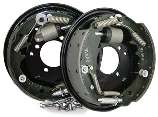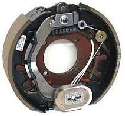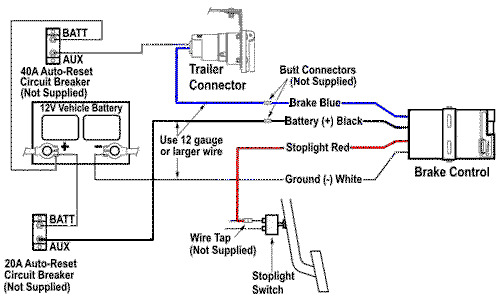The MGA With An Attitude
BRAKES For Trailers - TH-112
This article is almost off topic for MG cars, as most trailers under 1000 pounds do not have brakes. Also a reasonable trailer weight limit might for MG might be 500 to 600 pounds maximum, or 1/4 of the weight of the tow vehicle. However, if you intend to tow a 500 pound trailer regularly with an MG, you might consider trailer brakes. Besides, someone asked, and I happen to know a little about it. As a matter of convenience I will hereafter refer to the towing vehicle as the "truck".
 Surge Brakes:
Surge Brakes:
 In years past, small to medium size trailers may have used Surge Brakes. This has a hydraulic master cylinder built into the tongue of the trailer with a sliding joint, and hydraulic brakes on the wheels. When you apply brakes on the truck the deceleration rate comes into play along with weight of the trailer. With deceleration of the truck, inertia of the trailer causes forward force on the hitch to compress the master cylinder. The braking force needs to be limited so it will not lock up the trailer wheels, so the trailer brakes are commonly a little undersize.
In years past, small to medium size trailers may have used Surge Brakes. This has a hydraulic master cylinder built into the tongue of the trailer with a sliding joint, and hydraulic brakes on the wheels. When you apply brakes on the truck the deceleration rate comes into play along with weight of the trailer. With deceleration of the truck, inertia of the trailer causes forward force on the hitch to compress the master cylinder. The braking force needs to be limited so it will not lock up the trailer wheels, so the trailer brakes are commonly a little undersize.
In theory, more weight on the trailer makes more inertia which in turn makes for more force applied to the brakes via the master cylinder in the trailer tongue coupling. In the real world this is a very tricky balancing act that very often does not work out well. When backing up, especially backing up hill or in soft ground, the pushing force may apply the surge brakes and lock up the trailer wheels so it won't move. Sometimes that may happen if it just gets a sudden hard push. Assuming it doesn't lock up there will be no trailer brakes available when backing up. Backing down a boat ramp can be very dicey with no trailer brakes.
Surge brakes are popular with trailer rental agencies, as it does not require having a control module installed in the tow vehicle. For more information on surge brakes, acceptable applications and legalities, check out www.forconstructionpros.com.
Electric Brakes:

 Electric trailer brakes are more user friendly and accept better control input. These are usually in the form of drum brakes with a mechanical actuator arm inside, similar to a mechanical parking brake. There will be an electric magnet similar to a solenoid that will push or pull on the lever to apply the brakes. Each wheel will have a self-contained electric brake assembly. Braking force is determined by the amount of electrical current in the magnet. The current will be controlled by an in-vehicle electric brake control.
Electric trailer brakes are more user friendly and accept better control input. These are usually in the form of drum brakes with a mechanical actuator arm inside, similar to a mechanical parking brake. There will be an electric magnet similar to a solenoid that will push or pull on the lever to apply the brakes. Each wheel will have a self-contained electric brake assembly. Braking force is determined by the amount of electrical current in the magnet. The current will be controlled by an in-vehicle electric brake control.
The controller gets power form the truck battery, and gets a signal input signal from the truck brake light circuit. Touch the brake pedal just enough to make brake lights come on, and the trailer brakes work. There may also be a button on the controller to do the same thing so you don't have to touch the brake pedal. If you apply 12 volts the trailer brakes are capable of locking up the trailer wheels with a full load on the trailer, as long as you don't exceed the gross load rating capacity of the electric brakes. To keep it from locking the wheels you need to reduce the voltage and current using the brake controller unit. There are two different types of controller to accomplish this in slightly different manner, the Time Delayed Brake Controller and the Proportional Brake Controller.
Time Delayed Controller:
The time delayed controller is the simpler and (usually) cheaper unit. There are two adjustable controls on this unit, one for maximum current and the other for rise time. Take the trailer for a short 10 MPH stroll in an open area. Turn the current control up until the trailer tires lock up, then turn it back to reduce braking power just enough so the brakes will not skid the trailer tires. Trailer then has maximum braking force relative to gross weight. This works exactly the same for any load weight and for any pavement conditions, even in rain, snow or mud. Give it maximum braking ability without locking up the wheels. You can do this any time you hitch up the trailer, regardless of load on the trailer, and you can do it within the first half block of travel when you hit the road. You can do it again any time the pavement conditions change. It is rather like a manual version of anti-lock brakes.
The second control is for rise time, or how quickly the brakes come up to full power. This is a gradual-on function so it will not jam on full braking force instantly. Commonly set this to about 2 seconds, but if you are in heavy traffic that might require a very quick stop, then maybe one second. When you hit the brakes the truck brakes stop the truck and the trailer brakes stop the trailer, with a second or two for rise time on the trailer brakes. If it is not a panic stop, that is if you want to slow down gradually, then just touch the brake pedal gently to actuate the brake lights. The trailer brakes come up gradually in a couple of seconds to full force, and will slow the trailer and the truck at a reduced braking rate. This depends on relative weight of the trailer compared to weight of the truck; a heavier trailer will slow it down quicker. If you're not in a big hurry to slow down or stop, the trailer brakes will do all the work. If you need to stop quicker, then also apply some additional brake force on the truck as needed.
One odd characteristic of time delayed electric trailer brakes is that after they rise to full force within a couple of seconds they stay at full force until released, and then drop to zero force instantly. If you have your toe gently on the brake pedal, then the trailer will continue with maximum braking until the vehicle comes to a complete stop. If that is too much braking, then while still in motion lift your toe and the brakes will release completely, then touch the pedal again to restart the trailer brake rise cycle, and repeat as desired. To stop quicker, use the truck brakes in a normal fashion. Just keep in mind that there is a rise time delay on the trailer brakes, so if you jam the brake pedal in a panic stop there will be a second or two before the trailer brakes are up to full force. Leave a little extra space between you and the car ahead for increased braking distance when towing.
Proportional Brake Controller:
With a proportional brake controller, once the brake pedal is stepped on, a motion sensing device knows how fast the truck is stopping. It then applies power to the trailer brakes equally as fast (or slow) as the truck. This allows the trailer to brake at the same "rate" as the tow vehicle. Therefore, in an extreme stopping situation where the vehicle brakes are slammed on, the proportional controller will immediately send the maximum preset power to the trailer brakes.
This type of brake controller provides the smoothest and quickest braking while also providing the least amount of wear on both the truck and trailer brakes. It also allows feathering of the brake pedal for fine control of deceleration, and a slight release of the pedal will reduce trailer braking force similar to the truck braking action. Proportional controllers are enabled by the brake pedal switch and activated by a "pendulum" circuit that senses the vehicle's stopping motion and applies a proportional voltage to the trailer brakes. When properly adjusted the trailer will brake at the same rate as the truck, increasing braking efficiency and reducing brake wear on both vehicles.
Similarities::
Allow the user to adjust the maximum braking power to match the weight of the trailer
Have a manual override trigger that can be used to apply only the trailer brakes
Have the same wiring configuration for installation
Differences:
Cost: Time Delayed will typically be less expensive, although recent advances in Proportional Brake Controllers have made the cost difference much narrower.
Braking Performance: Time Delayed always sends the same braking power to the trailer, Proportional will vary the braking power based on how quickly the tow vehicle is stopping producing a smoother braking action.
Wear and Tear: Time Delayed will cause more wear on either the trailer or vehicle brakes because one or the other will be doing the majority of the braking. Proportional reduces wear by spreading the braking power evenly.
Mounting: Time Delayed may be mounted in any position and at any angle. Proportional will typically need to be mounted within a certain range, such as within 70 degrees of level, to work properly.
Calibration: Time Delayed will typically not require calibration. Some models of Proportional brake controllers need to be calibrated to work properly, but most of the newer models are self calibrating or have a very simple calibration, so they are nearly as easy to set up as time delayed.
Size: Time Delayed have traditionally been smaller and slimmer than Proportional, but newer models of proportional controllers come in shapes and sizes very similar to Time Delayed.
Use: Time Delayed are best for the casual user. Proportional should be considered if the trailer will be towed often because they operate well in diverse towing conditions and produce less wear on the braking systems.
Safety: Proportional brake controllers provide an additional level of safety because they will automatically ramp up to full power if the tow vehicle makes an emergency stop.
|
Typical Brake Control Wiring Diagram
Hitch supplied brake controllers require 4 wire connections:
Trailer Feed (usually blue): This is the wire that supplies brake power for the controller to the 6-way or 7-way trailer connector at the back of the vehicle. Some vehicles with factory tow packages already have this wire run from under the dash to the rear of the vehicle. Otherwise, the wire will need to be run along the underside of the vehicle and through the firewall to the desired Brake Control mounting location. To get through the firewall, sometimes a hole must be drilled. However, grommets or pre-existing holes are already available in most vehicles.
Ground (usually white): This wire is connected from the brake controller to any reliable ground location.
Brake Switch (usually red): This can be found near the top of the brake pedal. There are wires extending from the switch and using a circuit tester, the wire that has power when the brake pedal is pressed can be found. This wire is tapped into using a scotch lock.
Battery Power (usually black): This is the connection that supplies power to the brake controller. Some vehicles with factory tow packages already have this wire run from under the dash to the battery with some kind of circuit protection. Otherwise, a wire must be run through the firewall and connected directly to the battery with an in line circuit breaker.

Notice in this diagram the battery is supplying power directly to the trailer brakes, and the controller is sinking current to ground as the control method. In this case to measure voltage going to the trailer brakes you need to measure voltage between blue and battery rather than between blue and ground. If you measure between blue and ground the voltage reading will be inversely proportional to braking force (backward reading).
I suppose the reason it is done this way is because with a 6 or 7 pin trailer connector there is already a hot power feed to the trailer to operate accessory devices, like a winch or interior lighting. Trailers do otherwise have a ground connection to operate rear lighting. If the electric brake return circuit ran through the trailer ground wire, high current could result in some measurable voltage on the ground wire which would in turn reduce intensity of the rear lights (which have separate power feeds).
|




